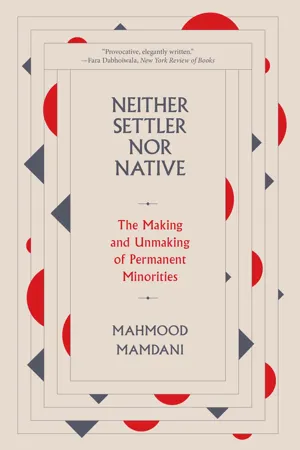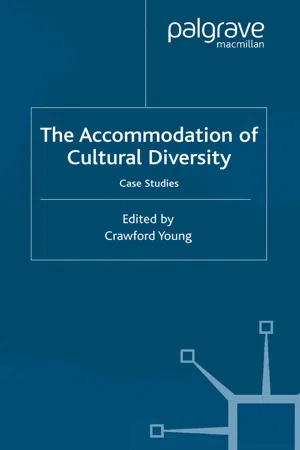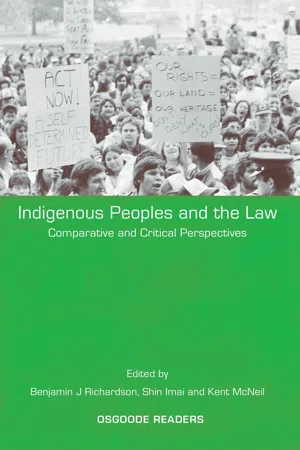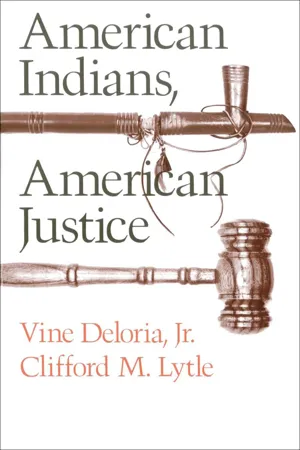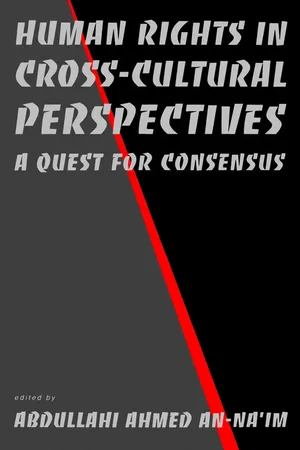History
Indian Civil Rights Act
The Indian Civil Rights Act, enacted in 1968, aimed to protect the civil rights of Native Americans living on reservations. It provided certain protections similar to those in the U.S. Bill of Rights, such as freedom of speech, religion, and assembly, as well as due process and equal protection under the law. The act also affirmed tribal sovereignty and self-governance.
Written by Perlego with AI-assistance
Related key terms
1 of 5
7 Key excerpts on "Indian Civil Rights Act"
- Susan Sleeper-Smith, Juliana Barr, Jean M. O'Brien, Nancy Shoemaker, Scott Manning Stevens, Susan Sleeper-Smith, Juliana Barr, Jean M. O'Brien, Nancy Shoemaker, Scott Manning Stevens(Authors)
- 2015(Publication Date)
- The University of North Carolina Press(Publisher)
and Clifford M. Lytle’s The Nations Within: The Past and Future of American Indian Sovereignty. Chapters within this text, however, contain a more sophisticated approach to understanding the distinctions and include some detailed policy analysis that U.S. history survey students might find challenging. With that said, the text does offer an insightful and informative perspective on how civil rights dominated policy decisions and affected American Indians fighting for sovereignty rights. For example, Deloria and Lytle explained how the 1968 Indian Civil Rights Act—a title that will naturally imply a positive outcome to students—actually threatened aspects of tribal sovereignty. “The Indian Civil Rights Act (ICRA),” Deloria and Lytle wrote, “radically changed the substance of tribal courts. It incorporated the First Amendment and Fourth through Eighth Amendments into a package of enumerated rights that tribal governments were forbidden to abridge.” 14 As Deloria and Lytle explained, “The Indian Civil Rights Act transforms the aboriginal sovereignty by objectifying it in institutions designed by non-Indians.” 15 Presentation of such arguments will begin to help students understand the distinctions between sovereignty rights and civil rights as rights of a separate nation from those of individuals within a nation, respectively- eBook - ePub
Neither Settler nor Native
The Making and Unmaking of Permanent Minorities
- Mahmood Mamdani(Author)
- 2020(Publication Date)
- Belknap Press(Publisher)
Santa Clara Pueblo v. Martinez (1978), bluntly denying that ICRA violations are subject to federal remedies. The ICRA can only be enforced in tribal forums.The ICRA’s omissions can be read as culturally sensitive efforts to allow Indians to maintain tribal traditions, such as their court procedures and the quasi-theocratic practices in place at some reservations.106 But these traditions are not actually traditional; they refer to colonial tools of indirect rule, whereby settlers instrumentalized what they claimed to be Indian traditions. What is protected as tradition is actually colonial customary law.107Not only these so-called traditions but also the protectors signal wardship. Indian self-governance is like the tribal self-governance of the South African Bantustans I discuss in chapter 3 : it may look like self-rule, but it is carried out under the eye of a settler state. Reservations do not have representation in Congress; instead they have an authority—tribal government—that represents the tribe to the BIA. Usually this tribal government is elected, but this is not enough. The authority must be approved by the secretary of the interior. The outcome is a hybrid combining features of democracy, autocracy, and standard-fare colonial bureaucracy. The chief executive of a tribe presides over its legislative body and executive branch; most tribes have no judicial branch. Decisions of tribal authorities must be approved by the secretary of the interior before they can be acknowledged as laws. The BIA provides funding—just enough development and security dollars to keep tribal governments on life support—while otherwise trying to do everything on its own: from building roads and dams to fighting fires and administering probate.108 - eBook - PDF
The Accommodation of Cultural Diversity
Case-Studies
- C. Young(Author)
- 1999(Publication Date)
- Palgrave Macmillan(Publisher)
The Act was the centrepiece of several measures aimed at redefining the relationship of the American polity to the Indian nations. Native Americans continued to suffer more than any other group the many ills associated with poverty, but the symbols and the rhetoric had changed and a framework was evolving to provide a measure of self-determination for Indian tribes. In 1975, Congress created the American Indian Policy Review Commis- sion, composed of Senators and members of the House of Representatives and five Indian members representing major tribes and Indians as a whole. The staff were mostly Indian, and 31 of 33 taskforces were chaired by Indians. Only one Congressman on the Commission disagreed with the funda- mental premise of its report that American Indian tribes are nations that should have the power to govern their internal affairs. The spirit of the recommendations made by the Commission was generally accepted in Congress, which had already passed in 1976 the Indian Health Care Improvement Act, aimed at improving the delivery of health care on reser- vations and training Indian professionals in modern medicine. In 1978, it passed the Indian Civil Welfare Act, granting authority over child custody and related cases to tribal courts. In the same year, Congress passed the Native American Religious Freedom Act, which obliged federal agencies Lawrence H. Fuchs 178 to refrain from any action or policy that would interfere with the practice of traditional Indian religion. Of course, under the American system of federalism, states could still do that to protect the health, welfare, and security of the people generally, as in the passage of state laws forbidding the use of peyote. By 1990, the census recorded that a growing number of Americans were native American Indians. Nearly 2 million were counted, of whom 411,000 were identified as living on reservations. - eBook - PDF
Indigenous Peoples and the Law
Comparative and Critical Perspectives
- Benjamin J Richardson, Shin Imai, Kent McNeil(Authors)
- 2009(Publication Date)
- Hart Publishing(Publisher)
Also, in 1977, the Senate Committee on Indian Affairs was re-established (it had been dis-banded in 1946), with jurisdiction including into proposing legislation to deal with such issues as Indian education, economic development, health care, and claims against the US government. 150 Other legislative reforms continued, although with somewhat less intensity, in the ensuing years, such as the Native American Graves Protection and Repatriation Act, 151 the Native American Languages Act, 152 and the American Indian Religious Freedom Act. 153 Specific reforms to recognise land rights and allow for a measure of self-governance were also adopted for Indigenous communities in Alaska and Hawaii. 154 The following sections concentrate on those reforms related to the reassertion of tribal status and self-governance. 70 Benjamin J Richardson 143 Pub L No 90-284, 82 Stat 73 (1968). 144 It has been pointed out that Indians did not lobby for the Indian Civil Rights Act. According to McSloy, ‘it was a state’s rights issue. It was introduced by Sam Ervin, Senator from North Carolina, to take the heat off civil rights violations by southern states by pointing at tribal governments as allegedly more egregious violators’: SP McSloy, ‘A Bird’s Eye View of American Indian Law and its Future’ (26 September 2003) Indian Country Today , at www.indiancountry.com. 145 President RM Nixon, ‘Message from the President of the United States Transmitting Recommendations for Indian Policy’, HR Doc No. 91-363, 91st Congress (2d Sess, 1970). 146 American Indian Policy Review Commission, Final Report (US Government Printing Office, 1977). 147 Pub L No 94-437, 90 Stat 1400 (1976). 148 Pub L No 93-638, 88 Stat 203 (1975). 149 Pub L No 95-608, 92 Stat 3069 (1978). 150 See indian.senate.gov/public. 151 Pub L No 101-601, 104 Stat 3048 (1990). 152 Pub L No 101-477, 104 Stat 1153 (1990). - eBook - ePub
- Deloria Vine, Clifford M. Lytle(Authors)
- 2022(Publication Date)
- University of Texas Press(Publisher)
Even though the 1968 Indian Civil Rights Act imposed these libertarian guarantees on tribal criminal proceedings, the practical implementation of the act has been more symbolic and looking toward the spirit of the law than a rigid application of the letter of the law. Take, for example, the right to counsel provision. Under federal and state laws, a defendant is afforded the right to counsel whether or not he or she can afford one. Under the Indian Civil Rights Act, an Indian defendant is permitted right to counsel only if he or she can afford to hire an advocate and an attorney. Furthermore, in many tribal court proceedings, the advocate-attorney defense team is expected to participate in the resolution of the problem and not to raise technical procedural points used in federal and state courts to free guilty defendants. The spirit of the law is maintained but the technical battles that characterize non-Indian courts and sometimes lead to a sense of outrage in non-Indian society are usually not present. Rigid application of the constitutional protections in tribal courts might well hamper the ability of the judiciary to function as it has. Tribal courts might well become as complicated as have the lower federal courts with cases waiting for years before they are resolved.AMERICAN INDIAN RELIGIOUS FREEDOM
Religious freedom has been extremely important in the historical development of our country. Indeed, one of the reasons that many people came to America originally can be attributed to religious intolerance in their home countries. Testimony to the importance of religious freedom to American political thought may be found in the First Amendment to the Constitution, which contains two clauses dealing with religion. The first of these is the Free Exercise Clause, which is designed to permit people to worship as they see fit or to not worship at all. The second clause, referred to as the Establishment Clause, creates a wall of separation between church and state so as to make certain the government is not dominated by the church and religion is not controlled by the state. The Establishment Clause, from a legal standpoint, is largely concerned with problems involving either (a) the use of public funds appropriated for religious purposes (such as federal aid to parochial education) or (b - eBook - PDF
- Edward Sidlow, Beth Henschen, Edward Sidlow(Authors)
- 2021(Publication Date)
- Cengage Learning EMEA(Publisher)
His native language was an unbreakable code for transmitting information on the battlefields during World War II. Why might many Americans be sympathetic to the Indian rights movement? Copyright 2022 Cengage Learning. All Rights Reserved. May not be copied, scanned, or duplicated, in whole or in part. Due to electronic rights, some third party content may be suppressed from the eBook and/or eChapter(s). Editorial review has deemed that any suppressed content does not materially affect the overall learning experience. Cengage Learning reserves the right to remove additional content at any time if subsequent rights restrictions require it. 115 Chapter 5: Civil Rights with disabilities, especially those with facial deformi- ties or mental impairments, face social bias. Although attitudes toward persons with disabilities have changed considerably in the last several decades, such persons continue to suffer from discrimination. Persons with disabilities first became a political force in the 1970s, and in 1973 Congress passed the initial legislation protecting this group—the Rehabili- tation Act. This act prohibited discrimination against persons with disabilities in programs receiving federal aid. The Individuals with Disabilities Education Act (formerly called the Education for All Handicapped Children Act of 1975) requires public schools to provide children with disabilities with free, appropriate, and individualized education in the least restrictive envi- ronment appropriate to their needs. The Americans with Disabilities Act (ADA) of 1990, however, is by far the most significant legislation protecting the rights of this group of Americans. The Americans with Disabilities Act The ADA requires that all public buildings and public ser- vices be accessible to persons with disabilities. - eBook - PDF
Human Rights in Cross-Cultural Perspectives
A Quest for Consensus
- Abdullahi Ahmed An-Na'im(Author)
- 2010(Publication Date)
- University of Pennsylvania Press(Publisher)
The Indian Law Resource Center, a leading advocate of Indian rights in inter-national arenas, correctly notes, however: Many Indians believe that the group rights of Indian peoples are the most important and most endangered of all Indian rights. These rights would in-clude the right to self-government and the right to maintain communal own-ership of land and resources. As groups, peoples, communities, tribes and nations—not just as individuals—Indians are asserting the right to self-government, the right to determine their own relations with other nations and other peoples, and the right to preserve their cultures, languages, and religions. 27 Keeping in mind the importance of group rights as a fundamental human right for Indians, how may one develop a definition of those rights? The first approach, as it has been with others, is content-oriented. One may develop a comprehensive corpus of Indian human rights law by addressing social and economic conditions, acknowledging Indian de-mands, and by unifying the growing literature of aboriginal international 196 James W. Zion rights law. The second approach is to examine the common base values of the Indians of North America. SOCIAL CONDITIONS The Indians of North America fall at the bottom of every indicator of social and economic well-being. A starting point for their human rights law is the census. The 1980 United States Census (which most agree un-derenumerated Indians) shows there arc approximately 1.5 million Native Americans there, about one-half of one percent of the national popula-tion. 28 About half of the Indian population lives in the American West, mostly in the states of California, Oklahoma, Arizona, and New Mexico. One-third to one-half of the Indian population lives in cities.
Index pages curate the most relevant extracts from our library of academic textbooks. They’ve been created using an in-house natural language model (NLM), each adding context and meaning to key research topics.

